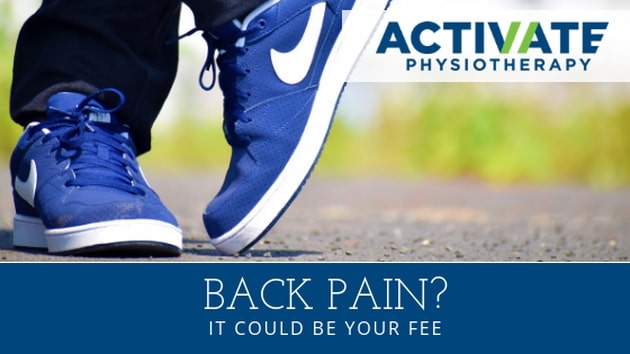I often see people at our Brisbane physiotherapy practices with back problems. If you’ve tried everything to fix you back, pelvic or hip pain, have you tried looking further away down to your feet?
Bare with me Activators this isn’t me going all new age and saying if i push here it’s going to fix something somewhere else. I’m referring the effect your feet have on whats known as your biomechanical chain.
It’s common for people to focus on the specific site of pain, heck even some physios when they’re starting off do some wonderful things on a persons back only to have them come back in next visit saying “oh it helped for a little bit but then it came right back.” Sometimes we have to look further afield and what better place than the two things that keep you firmly planted on the ground – YOUR FEET!

There’s that old song – The foot bone’s connected to the shin bone, the shin bone’s connected to the knee bone… OK you know the one. Well that song my friends describes the biomechanical chain. It’s really just fancy physio speak for saying your posture begins right down at your toes.
If you have flat feet or high arches it can affect whether your knees rotate inwards when you walk, it can change the way your legs absorb forces from movement or simply standing still and it can change the load through your hips, pelvis and lower back causing pain. Compounding this your choice of footwear (or lack of) and the surfaces you stand on all play a part too.
So what are some signs that your feet might be responsible for or limiting your improvement from back pain?
- Do you have flat or highly arched feet?
- Have you noticed you in-toe (stand pigeon toed with your toes pointing towards each other rather than straight ahead)?
- Do you have knock knees (knees turned more inwards that may even knock together when you walk or run)?
- Does wearing different types of shoes make your back better or worse?
- Does being on different surfaces change your pain (running on the grass rather than road running)?
- Does your back feel worse after a day on your feet?
- Have you noticed your shoes wearing out in a particular way?
- Do you tend to hang on your hips (stand on one leg and let the opposite hip drop)?
If any or all of these sound like you here’s what you can try:
CHANGE YOUR SHOES
Try wearing the ones that seem to make the pain reduce. Generally speaking these are likely to be ones that support your feet and provide the best cushioning. But before you head out to buy the latest and greatest runners, don’t forget all shoes and feet are not equal. You need to buy shoes that are right for YOUR feet and these may not be the most expensive ones.

Experiment with shoes you already
own so you can see if you can work out what it is about them that might be beneficial.
- Is it the cushioning
- Do they have a heel or are they flat
- Are they very structured and supportive
- Do they have a rigid or more flexible sole
- Are the straps wide or thin
TRY TAPE
Your physio can use strapping tape to provide a short term improvement your foot function and unload the structures further up the chain. If this works it can be a good sign that certain shoes or orthotic insole supports might assist in the longer term.
START STRENGTHENING

It isn’t just a matter of hitting the gym here. You need to have your physio look at what muscles might be weak or tight. This can be around your foot and ankle or further up around your hips, bum and thighs. We often notice a certain pattern that causes back and hip pain so as physios we look to correct these muscle patterns through a series of exercises for your core, butt and other leg muscles.
These are just some hints to get you started. If you feel like your feet might be causing you problems you should speak with your physiotherapist, podiatrist or doctor.

